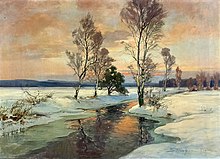Johannes Müller (engineer)
Johannes Müller (* around 1695 in Grünewalde ; † 1764 in Senftenberg ) was the first contractor for hydraulic engineering systems in the service of Baroness von Löwendahl and the Saxon ruling house from 1725 to 1748 . Müller was a planner, architect and building contractor in one person.
Live and act
Johann Müller was born between 1695 and 1700 as the son of the village miller Andreas Müller zu Grünewalde. During his school days he spent the winter in the house and completed his apprenticeship as a miller with his father. From 1724 it is known that Andreas Müller worked in the Grünewalder Dorfmühle, his son lived and worked in the Mückenberger Schlossmühle of Benedicta Baroness von Löwendal .
Water for the Löwendahl melt
The baroness also knew that the millers knew how to use leveling equipment and therefore asked him for advice on the practical installation of a blast furnace in matters of energy procurement, and then entrusted him with the implementation of the hydraulic engineering works for the new iron smelter. "By applying the raft trenches Gohra by Finsterwalder, Dobrilugker, Liebenwerdaer, Mückenberger and Elsterwerdaer Forestry to plessa, and the raft Canals of Elsterwerda to Grödel on the Elbe River in the 1740s, and after that glorious became known, from Grünewalde at Wasser-Müller, Johann Müller, who came from Mückenberg and in whom the Mückenberg rulers discovered many facilities and a real practical eye, was consulted, and by him, after just by eye measure, he took the electoral haide, between the Lauchmühle and leveled the Spiegelhütte Friedrichsthal, had suggested the current location at the Lauchmühle to build the blast furnace "
In doing so, Müller also indirectly referred the village of Lauchhammer, which would later be created, to its current location. In 1725 he began working on the water supply to the ironworks by creating a pond at a suitable location while maintaining the highest possible water tension ( water level ), which as a buffer ensured a continuous flow to the water wheels. Müller increased the catchment area from 10 to 30 km² at the beginning. The blast furnace was built, the Hammegraben and Hammerteich pond were built, in 1726 for the Oberhammer, the Mittelhammer and in 1728 for the Unterhammer, as well as the continuation to the Plessa district to drain the Löwendahl wet areas. (It was not integrated into the raft ditch until 1801). In 1728 Müller made the suggestion to relocate the Pößnitz with "1899 Ruten neue Graben" and to bring it to the factory. Of course, he continued to play an important role in advising on the establishment of the plant and the hammers, and the miller's water was still used until the beginning d. Used in the 20th century and then replaced by electricity.
The construction of the Finsterwalde-Elsterwerda-Grödel ad Elbe rafts
It is a mistake to assume that the development of iron smelting would go unnoticed in the royal seat and so the Löwendahls were able to recommend the water miller for the upcoming Saxon water projects with a clear conscience, not entirely without self-interest, as a waterway to the Elbe solved many a transport problem. In fact, this was used intensively by the Löwendahlschen and later by the Einsiedelschen works, including the Schwarzen Elster to Dolstheida and the Hammergraben to Unterhammer, for the interests of the iron works Lauchhammer and later also Gröditz . For example, Müller certainly had the advocacy of the Löwendahls for the “Elsterwerdische Rafts” project, without such an order one would certainly not get such an order. In 1735, a government commission, to which Johannes Müller belonged, had to examine whether it would make sense to build a raft of wood for the mutual benefit of the wood sales and the Saxon State, which is suffering from lack of wood. According to a commission, 9,000 solid cubic meters of wood could be removed from the forests around Finsterwalde , Grünhaus and Elsterwerda, as well as from Schraden , without damaging the forests and wildlife. Ultimately, the raft ditch was built from the Finsterwalder Forst to the Schwarzen Elster and the Elsterwerda-Grödel raft canal from the Schwarzen Elster to the Elbe, which Müller was commissioned to carry out. He received 5,800 thalers for the construction of the raft ditch , 34,000 thalers for building the raft canal, while the lock builder G. Findeisen was to receive 18,171 thalers. It is therefore clear that Müller not only had to level the entire raft, but also built it. Some sources show that Müller even had to pay with his life if the project failed. Leveling work was carried out by the Saxon military as early as 1736. Work on this water project began in 1741 and in 1744 the approx. 35 km long raft ditch was completed. Even this part of the rafts was a masterpiece compared to the possibilities at the time. Müller knew how to level a functional raft ditch with small amounts of water and a minimal gradient (0.5 m / km) , some of which went above ground level with dams reinforced with brushwood. 17 bridges, some with weirs, had to be built. Rafted should from lumberyard Sorno to the lumberyard Elsterwerda be, from there to the Elbe should Treidelschiffe provide transportation. The work on the raft canal, however, lasted until 1748. With a length of 21 km, an average width of 7 to 9 m, a depth of 1.4 to 1.6 m, equipped with 3 chamber locks, it was the largest and with a construction cost of 65437 thalers also the most expensive sewer project of a small German state of the time. On January 23, 1748, Müller declares that the canal against Johannis will be completed and also gives the following: "Alone there was a very sad incident in front of me, which means that I missed out on my hard work and hard work, and about this with my wife and children would probably even get to the begging staff if Em. Kgl. Your Majesty does not have mercy on me. "
He claims to have got his belongings by building the canal because he took it over too cheaply. With such a large project, you cannot plan everything “accuratissime”. Müller stated that he had to use his funds for 7 years and described all the unplanned events that should have caused this. He therefore asks for an additional payment of 1700 thalers, of which 1400 were granted. Again he asks even more urgently for 1200 thalers, otherwise he would not be able to finish the canal. After threatening coercive measures, his request was finally granted, the 1200 thalers were granted and the expectation was expressed that he would “not undertake any further harassment”. The project ended and the canal was filled from the Röder without a direct connection to the Elbe being established. Instead, it had to be reloaded from a harbor basin into the Elbe, which is 3.5–4 m lower . Why Müller preferred this solution is unclear, as a double lock was planned at this point. But the channel, and this was important, worked. 17 bridges had to be built and many a dispute with allegedly damaged landowners cost extra concessions. For his services, Müller was awarded the title of “Royal (Prussian) Elector (Saxon) Master of Hydraulic Engineering”. His workers were called Master Hannusch .
The time after the canal was built; Berufsmüller and construction of the Wendish Church in Senftenberg
One year after the rafts were completed (1749), Müller appeared as the builder of the Wendish Church in Senftenberg and built it as a wooden structure estimated at 1158 thalers, made of stone for 539 thalers and 11 groschen "to the glory of God, the best of the church and his name ". And this entirely of his own free will, because his clients could not have raised larger amounts. The settlement of the bill was also quite slow, so that Müller had to refuse the keys for the time being. However, 90 years after it was built, the church became so badly dilapidated that it had to be renovated at great expense. This church is still preserved today as the Wendish church . Müller is now the owner of the Wolschink mill near Sedlitz and Amtsmüller in Senftenberg . According to Armer, he is said to have even bought a manor near Senftenberg .
The thought of a Spree-Elster canal
The Grödel-Elsterwerda canal construction apparently did not deprive him of his belongings. In the meantime, people in Saxony were looking for new sources of wood, especially hard woods that were to be fetched from the Spreewald . At that time, water transport was the only way to carry large quantities over long distances cheaply, although the construction of a waterway is quite laborious. And so one remembered the expert for such projects. “You are asked to send the former hydraulic engineer Johann Müller so that he can draw a line, weigh it, submit a crack and bring the costs into a reliable estimate. The cost of his work, 1 Reichstaler per day , can be paid by the Elsterwerdaer Raftkasse. The raft master Schubert in Elsterwerda was instructed on April 8th to give such money, to assist the hydraulic engineer with advice and help and harness horses as often as he needed ”.
Müller and his son immediately brought the requested attack and a. in 2 variants, whereby he suggests the Spreewald, " Luckau , Beßda (Beesdau), Kleinbora (Kleinbahren), Floßgraben at the Finsterwaldische Brettmühle" route as the cheapest, but advises against all plans. But if it came to construction, the seat of the building authority should be in Senftenberg. It never came to that. A busy and fulfilling life came to an end in 1764. Johann Müller was buried under his honorary title in Senftenberg on November 13th.
See also
literature
- JF Trautscholdt “History and Feyer d. 1st cent. Eisenwerkes Lauchhammer, "(Dresden, 1825)
- Pastor Böttger, Gorden parish chronicle. 1868
- K. Mende, Riesa, in the "Schwarzen Elster" 1912 issues 147, 148, 149
- Grossenhainer home calendar 1998
- F. Stoy in the "Black Elster" March 31, 1931
- R. Armer, "The Historical Development of Our Home Area"
- “The creation of the raft trench to transport the wood from the Finsterwaldische and neighboring Heyden to the Königl. Residenz Stadt Dreßden ”, Dresden 1740–1752.
- G. Treyse, M. Rothe, "Lauchhammer Mill History", Finsterwalder Heimatkalender
- Dr. Zwingmann, “Local Report”, Lauchhammer, March 26, 1999
- F. Naumann, “The Hammergraben and its History”, Lauchhammer.
Web links
- K. Weinert, Chronicle of 1979 Grünewalde, Part III 2007
- The royal-electoral hydraulic engineer , accessed on August 13, 2010
Individual evidence
- ↑ a b J. F. Trautscholdt “Geschichte u. Feyer d. 1st cent. Eisenwerkes Lauchhammer, "(Dresden, 1825)
- ↑ a b c "Schwarzen Elster" 1912 issues 147, 148, 149
- ^ Pastor Böttger, Gorden parish chronicle. 1868
- ↑ "The creation of the raft trench for the transport of their wood from the Finsterwaldische and neighboring Heyden zur Königl. Residenz Stadt Dreßden ”, Dresden 1740–1752.
- ↑ a b c Senftenberger Paulitz Chronicle
- ↑ Grossenhainer Heimatkalender 1998
- ↑ R. Armer, "The Historical Development of Our Home Area"
- ^ "Schwarzen Elster" March 31, 1931
- ^ Church books of the Peter-Paul-Kirche, Senftenberg.
| personal data | |
|---|---|
| SURNAME | Müller, Johannes |
| BRIEF DESCRIPTION | German civil engineer |
| DATE OF BIRTH | around 1695 |
| PLACE OF BIRTH | Grünewalde (Lauchhammer) |
| DATE OF DEATH | 1764 |
| Place of death | Senftenberg |



